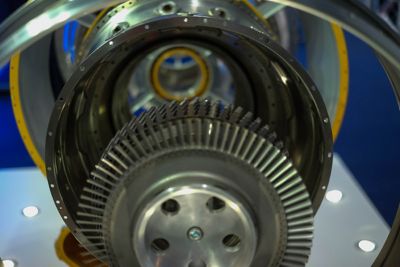ANSYS BLOG
June 23, 2022
Launching Aviation Into a Cleaner Future with Simulation-Powered Propulsion
As Earth’s average surface temperature continues to rise, largely due to an increase of carbon dioxide (CO2) emissions released into the atmosphere, sustainability remains a top priority for today’s aviation industry.
With aviation leaders vowing to reach net-zero carbon emissions goals by 2050, suppliers and original equipment manufacturers (OEMs) in the aerospace and defense (A&D) industry strive to adopt new initiatives and technologies to reach these goals safely.
One initiative encourages digital transformation to develop more efficient and advanced propulsion systems. By embracing digital transformation and integrating simulation into workflows, engineers can design cleaner, faster, and smarter propulsion systems that reduce carbon emissions, material use, and noise pollution.
From hybrid and electric propulsion to emerging hydrogen-powered technologies or traditional systems, simulation is improving design and development with confidence, speed, and predictive accuracy.
To demonstrate how simulation supports sustainability efforts throughout the A&D industry, Ansys will join top aviation leaders and nearly 1,500 exhibitors at the Farnborough International Airshow from July 18-22 at the Farnborough Airport in Hampshire, England.
Engineering Efficiency with Simulation
The optimization of propulsion systems requires thorough analyses of all aircraft architecture, including battery systems, gas turbines, control systems, and electric machines, such as motors or generators.
The optimization of each type of propulsion system has its own set of challenges.

Credit: Farnborough International Airshow
Hybrid and Electric Propulsion
With hybrid and electric propulsion systems, some of the toughest hurdles are developing safe and long-lasting batteries and fuel cells, managing the power-to-weight ratio, and airframe redesign to enable alternate energy storage.
Ansys’ multiphysics simulation can help in each of these areas by providing critical insights early in the design process. For example, finite element analysis (FEA) with simulation software such as Ansys Mechanical can be used to perform harmonic analyses for vibration and thermal analyses for temperature control. Similarly, computational fluid dynamics (CFD) can be leveraged with software such as Ansys CFX to improve aerodynamics of engine modules and the airframe.
Hydrogen-Powered Propulsion
Some OEMs are exploring alternative fuels, such as hydrogen, to reach net-zero faster. While hydrogen holds great promise for aviation, it also introduces a unique set of challenges.
To update propulsion systems to run on hydrogen, the engine combustor and injector need to be redesigned to burn hydrogen safely and effectively, composite storage tanks needs to be lighter and more reliable to store on-board cryogenic hydrogen, and cooling systems need to be in place and properly functioning to control high-pressure hydrogen temperatures. And those are just a few of the alterations that need to be considered.
Ansys’ simulation helps in each of these areas by offering:
- The capability to predict engine performance, autoignition temperature, thermoacoustic effects, risk of flashback, and lean blowout
- Material selection and automated design optimization tools
- Ansys Composite Cure Simulation (ACCS) tools, which enable teams to simulate thermal-chemical reactions and optimize the cooling process by predicting residual stresses and process-induced distortions during the curing of composite parts
For example, high-fidelity turbulence and combustion modeling in Ansys Fluent can be used to redesign the injection system and combustion chamber for burning hydrogen.
Traditional Propulsion
Primary goals for traditional propulsion systems — which still propel nearly all global aviation — are to improve efficiency and performance, reduce emissions, and increase reliability and safety.
These traditional propulsion systems using gas turbines also benefit from simulation to keep pace with rising demands for sustainability compliance and the evolving landscape of aviation.
By incorporating Ansys’ multiphysics simulation into workflows, engineers are able to meet these challenges using the same multidisciplinary approach to assess thermal, structural, vibrational, and aerodynamic components throughout the aircraft.
Also, as mentioned with other systems, material selection not only influences a product’s lifespan, but also its recyclability. Ansys Granta Selector material selection software enables engineers and designers to choose the best materials for product success and risk reduction, while validating materials for performance and regulatory requirements.
“To be successful in the future, engineering needs to consider the environmental viability and impact of the design, manufacture, and operation of products as well as emerging laws and regulations,” says Mike Slack, a technical account manager at Ansys. “All of this comes down to making smarter engineering choices to meet new design requirements, and where simulation and Ansys’ expansive portfolio can lend an abundance of aid. From choosing sustainable reusable materials and designing long-use retrofittable assets to developing new fuels and the energy sources that create them, simulation provides the tools to reshape a cleaner future in aviation.”

Credit: Farnborough International Airshow
Moving Onward and Upward
The A&D industry has already soared to greater heights with the help of simulation. Industry leaders have reported significant impacts of simulation in the movement toward net-zero emissions, including reduction in fuel burn and improvement of power density, energy efficiency, and maintenance cycle time. Additionally, with simulation’s ability to accelerate production and consolidate tasks, it acts as a collaborative tool, helping teams to connect designs, results, and with each other throughout development.
“Simulation contributes to efficient and advanced propulsion systems by enabling cost-effective, multidisciplinary design exploration, and connecting system modeling tools to physics-based models, while at the same time providing high-fidelity analysis models to judge the performance and safety of such designs,” says Mariano Morales, a senior technical account manager at Ansys. “In this way, simulation helps to shorten the certification process and connect ecosystems for radically enhanced collaboration between OEMs and suppliers.”
To register for the Farnborough International Airshow, visit their event site.